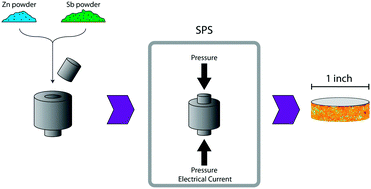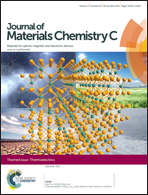Fast direct synthesis and compaction of phase pure thermoelectric ZnSb†
Abstract
ZnSb is a promising low cost, non-toxic thermoelectric material, but large scale applications require development of fast and easy synthesis methods. Here a thorough investigation of the influence of synthesis parameters (pressure, sintering time, maximum temperature, stoichiometry) are explored in direct one step Spark Plasma Sintering synthesis of ZnSb pellets from Zn and Sb powders. The homogeneity of the produced pellets is studied using conventional powder X-ray diffraction (PXRD), synchrotron PXRD, and spatially resolved maps of the Seebeck coefficient. Most of the synthesized pellets exhibit a large degree of inhomogeneity caused by zinc migration during the synthesis, but the detailed exploration of the parameter space lead to optimal conditions for producing virtually phase pure pellets. The characterization results from the many samples also suggest that ZnSb is not a line phase as commonly depicted in binary Zn–Sb phase diagrams. Phase pure pellets are used for multi-temperature synchrotron PXRD analysis to study the thermal expansion, thermal stability and lattice dynamics of the system. Based on analysis of atomic displacement parameters obtained from Rietveld refinement of the synchrotron PXRD data, the Debye temperature is estimated to be 175(1) K.

- This article is part of the themed collection: The Chemistry of Thermoelectric Materials


 Please wait while we load your content...
Please wait while we load your content...